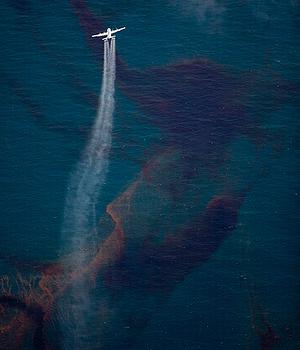 美國墨西哥灣幾個環保團體,透過《資訊公開法》得到的最新研究資料,發現經美國環保署批准使用於分解海上油污的57種化學成份裡,有5種含致癌物質。
美國墨西哥灣幾個環保團體,透過《資訊公開法》得到的最新研究資料,發現經美國環保署批准使用於分解海上油污的57種化學成份裡,有5種含致癌物質。
上述資料揭露在一份由「地球正義」(Earthjustice)環境法律事務所與「毒物百科資訊顧問公司」(Toxipedia Consulting Services)所提出的報告,其撰寫根據,是來自「地球正義」受海灣復育網絡、佛羅里達州荒野協會委託,透過資訊公開法要求美國環保署提供的資料。
BP(英國石油)在墨西哥灣嚴重漏油事件後的善後工作中,使用了超大量的除油劑,這些除油劑是為了清除海上漏油,所含化學藥劑能使石油分解為細小顆粒,以將它從海水表面溶解於水柱中。
所使用的除油劑包括COREXIT 9500和9527,均為Nalco/EXXON生產。短短三個月,BP總共用了180萬加崙溶劑。這期間位於路易西安那州東南海岸40哩處的瑪康多《Macondo》油田一地即排放了490萬桶原油。
該份報告名為《善後清理的大混亂──溶劑產品所含化學成份對人體與環境的衝擊分析報告》,特別指出有些溶劑比其他溶劑安全。
「試驗根本無法在災難發生時進行,」「地球正義」律師瑪莉安‧拉度說道,「必須事先測試,以免遭遇我們見證過的,面對『深水地平線號』油井災難反應時引起的混亂。」
該批化學溶劑和致癌有關的成份包括:
- Amides, coco, N,N-bis(hydroxyethyl)…歸類為可能致癌物
- Cyclohexene, 1-methyl-4-(1-methylethenyl)-, (4R)-…能使鼠類致癌
- Ethanol, 2-butoxy…為可能致癌品,
- 加氫輕餾分石油蒸餾物(Petroleum distillates, hydrotreated light),公認能使動物得癌症,但同樣對於人類也有不確定的影響。還得尤其小心這些蒸餾物,一旦吸入它的氣體會引起昏眩、頭疼、嘔吐、失去意識。長時間吸收高密度氣體很可能傷害呼吸系統。
報告指出,墨西哥灣周邊區居民不斷遭受因善後工作引發的健康後遺症。「我們觀察到的各式各樣的疾病都非常獨特,與以前見過的病例完全不同,」在路易西安那州雷思蘭小城行醫的麥可羅比察大夫如此說。
「稍早雖然曾接到許多病人投訴,但現在最大的問題是:失憶症、突發病痛 、腹痛、疲憊、易怒、以及其他一些與神經系統、內分泌系統有關的毛病。」他說。
「地球正義」從法院獲取一份合法使用的溶劑成份表,溶劑中所含化學藥物的安全使用報告,與溶劑生產商為取得產品檢驗通過,呈交給美國環保局的申請書和含毒測試結果。他們還設法要求所有有關環保局與BP就石油外溢事件選擇適當溶劑討論的往返書信。
「目標就是這樣:如果非使用溶解劑不可,我們會使用適合這特殊石油污染情況、含毒量最低的溶劑,」任職於佛羅里達州荒野協會的曼麗‧傅樂說。「想達成這目標,我們必須知道所有的成份,而且他們也必須先行就地試用」。
「海灣復育網」執行長希恩‧莎侯倒擔心沒經過公開程序,大眾不甚了解其影響的情況下,貿然選擇溶劑的後果。「盡管社會愈發關心已明列的溶劑的含毒量與其對環境的衝擊,」她表示,「環保局卻仍一味地保護著始終不肯公開溶劑產品成份的製造商的利益。」
Five of the 57 ingredients in dispersants approved by the U.S. Environmental Protection Agency for use on oil spills are linked to cancer, finds a new research report based on data obtained through a Freedom of Information Act request by environmental groups on the Gulf of Mexico.
The report from Earthjustice, an environmental law firm, along with Toxipedia Consulting Services, is based on material released by the U.S. EPA in response to a Freedom of Information Act request made by Earthjustice on behalf of the Gulf Restoration Network and the Florida Wildlife Federation.
Dispersants are used to clean up oil spills and contain chemicals that break up oil into smaller droplets and move the oil from the surface of the water into the water column.
A plane sprays dispersant over the oil leaked from the BP wellhead in the Gulf of Mexico, May 21, 2010. (Photo by Daniel Beltra courtesy Greenpeace)
Two oil dispersant products were used heavily in the BP oil leak: COREXIT 9500 and 9527, both produced by Nalco/Exxon. BP used over 1.8 million gallons of dispersant during the three-month long oil leak that gushed 4.9 million barrels of crude oil from the Macondo well located about 40 miles southeast of the Louisiana coast.
The report "The Chaos of Clean-Up: Analysis of Potential Health and Environmental Impacts of Chemicals in Dispersant Products" highlights the fact that some dispersants are safer than others.
"The testing can't be done in the moment of the disaster," said Marianne Engelman Lado, an attorney with Earthjustice. "It has to be done ahead of time to avoid the chaos we witnessed during the disaster response to the Deepwater Horizon disaster."
Among the dispersant chemical ingredients linked to cancer are:
- Amides, coco, N,N-bis(hydroxyethyl), which is classed as a likely carcinogen
- Cyclohexene, 1 - methyl - 4 - (1 - methylethenyl) -, (4R) -, which is classed as carcinogenic to rats
- Ethanol, 2-butoxy- which is listed as a possible carcinogen
- Petroleum distillates, hydrotreated light, which are classed as a confirmed animal carcinogens with unknown relevance to humans. These distillates carry the additional warning that exposure by inhalation can cause dizziness, headache, nausea, drowsiness, and unconsciousness and prolonged inhalation of high concentrations may damage the respiratory system.
Gulf residents continue to suffer health effects related to the disaster clean-up. "The illnesses we observed were quite unique and different from anything that I had ever witnessed before," said Dr. Michael Robichaux, a physician in Raceland, Louisiana.
"Although there were scores of complaints early on, the main problems at this time are a loss of memory, seizure type problems, severe abdominal pain, fatigue, irritability and other neurological and endocrine manifestations," he said.
Click here for a chart that breaks down the ingredients in dispersants and their effects on humans, wildlife and the aquatic environment.
Earthjustice went to court to obtain the ingredients of dispersants eligible for use, health and safety studies on the chemicals in dispersants, and the application materials and toxicity testing results submitted to EPA by dispersant manufacturers seeking to obtain eligibility status for their dispersant.
The request also sought correspondence between the EPA and BP about the selection of an appropriate dispersant during the Deepwater Horizon disaster.
"The goal here is, when dispersant use is required, we use the least toxic dispersants that are appropriate to that specific spill condition," said Manley Fuller of the Florida Wilderness Federation. "To do that, we need to know the ingredients and they need to be tested in field conditions."
Toxipedia.org has made information on the chemicals accessible to the public for the first time through its website.
Cyn Sarthou, executive director of the Gulf Restoration Network, is concerned that choices among dispersants are not being made publicly with full knowledge of their impacts.
"Despite ongoing concerns from the public about the toxicity of listed dispersants and their impacts upon the environment," she said, "the EPA continues to protect the dispersant manufacturers, who want to keep the ingredients of their products secret."

